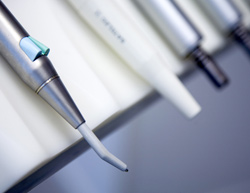No More Needles, No More Drills!
Back in the “olden days,” a child would visit the dentist who would check the child for any sign of tooth decay. If a cavity was discovered, the child would receive a hefty dose of Novocain, the tooth would be drilled, and then a silver amalgam filling would be inserted.

Air abrasion gently removes tooth decay – no drill required!
In this process, much of the healthy tooth, in addition to the decayed part, would be removed and as years went by, the amalgam might cause the tooth to break (fracture), requiring even more restorative work (i.e., root canal, crown, extraction, etc.).
Modern dentistry has changed all of that! State-of-the-art techniques, such as microdentistry and air abrasion, cater to patients who dislike anesthesia and drills when it comes to removing tooth decay.
What is Microdentistry?
The goal of today’s microdentistry is to find tooth decay as early as possible, to treat it by removing the least amount of tooth enamel, fill the cavity with a small amount of bonding material and then seal the tooth to prevent any further decay.
This type of restoration generally does not require any anesthesia, looks completely natural, and is designed to last a very long time. Instead of removing large areas of a tooth’s surface, the overall structure of the tooth remains intact, leaving as much of the “healthy” part of the tooth as possible intact.
Air Abrasion: No Shots and No Drill!
Air abrasion gently removes only that area of the tooth surface that is decayed – and nothing more. Using a device that sprays an air and abrasive powder mix on the tooth surface, it is easy to remove only the decayed area, leaving the remainder of healthy tooth intact.
A drill, because of its size, removes more of the tooth structure than is necessary, including the healthy part. Now, no noise, no drill, and no shot = an enjoyable dental experience. And… you don’t leave the office with a numb tongue and a droopy smile!
Advanced Technology = Early Detection and Restoration
The advanced technology detects tooth decay in its earliest stages, so the tooth can be restored well before more invasive restoration is needed. This technology is ideal for children as well as adults, because no anesthesia is required (so no painful shots) and no drill (big, loud and somewhat intimidating!) is used.

